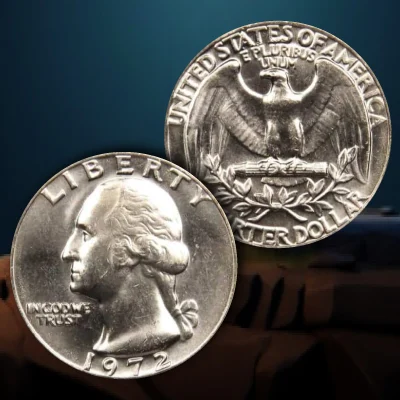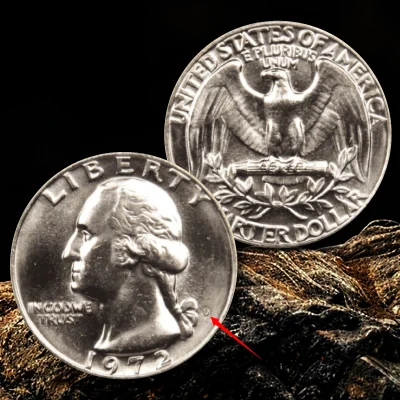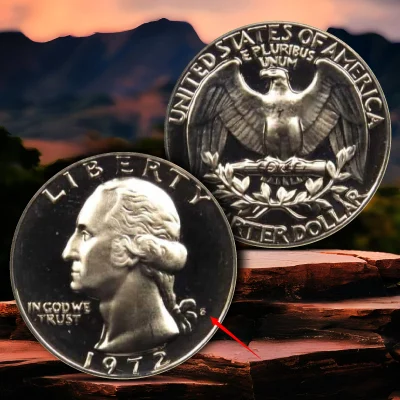You've come to the ideal place if you've been wondering whether you can
afford to get a 1972 quarter coin. As there are a lot of such quarters in
circulation, coin collectors' interest in this series may be less overall
due to the sheer quantity of coins in circulation. Some of the 1972
quarter value can even fetch values that exceed your expectations!
Finding one jewel among millions of other coins is the true art. So, let's
get started with determining the 1972 quarter value and discover
everything there is to know about this coin series.
1972 Quarters Value and Types
You've come to the ideal place if you've been wondering whether you can
afford to get a 1972 quarter coin. As there are a lot of such quarters in
circulation, coin collectors' interest in this series may be less overall
due to the sheer quantity of coins in circulation. Some of the 1972
quarter value can even fetch values that exceed your expectations!
Finding one jewel among millions of other coins is the true art. So, let's
get started with determining the 1972 quarter value and discover
everything there is to know about this coin series.
1972 Quarters Value and Types
The Washington Quarter was created by the US Treasury Department in 1932
as a commemorative coin for the country's first president, George
Washington, to celebrate his bicentennial. The 1972 Washington quarters
were part of regular coin circulation. This coin has a diameter of around
24.3 mm and a total weight of about 5.67 grams. One side depicts a
heraldic eagle and another George Washington's portrait.
The Mint manufactured 90% silver content containing Washington quarters
from 1932 to 1964. Nevertheless, future coins were struck using copper and
nickel instead of silver due to rising silver prices and a serious coin
shortage. Because of this, the 1972 quarter is made of an alloy of copper
and nickel rather than silver. The 1972 quarter value depends on various
factors, including errors, condition, mint marks, and rarity. Let's
explore the 1972 Quarter value and types.
1972 Quarter No Mint Mark Value

The production of quarters without a mint mark at the Philadelphia
Mint in 1972 was not a mistake. In fact, this is the main feature that
distinguishes these coins from the 1972 quarters made by the Denver
and San Francisco Mints. It is clear that this coin wasn't rare at
all, given the Philadelphia Mint's estimated total mintage of
215,048,000. Maybe this explains why these are available in circulated
condition for roughly 25 cents (face value).
However, that does not imply that there aren't any 1972 quarters
available in mint condition at all! Thus, the total worth of this coin
can increase to $5, which isn't too awful if you do locate it in a
completely flawless condition with no evidence of any damage at all.
| 1972 |
Philadelphia |
MS66 |
A few hundred |
Higher price due to rarity |
N/A |
| 1972 |
Philadelphia |
MS67 |
Very few |
$1,320 |
2018 |
1972 D Mint Mark Quarter Value

Quarters with the "D" mintmark from 1972 are particularly significant
in history because they were produced at the renowned Denver Mint.
Just glance at the small "D" on the front of the coin, just next to
Washington's hair tie, if you're wondering where it is. These
Denver-struck Washington quarters, which had an astounding 311,067,732
mint run that year, are anything but rare. Circulated 1972 quarters
are often worth exactly what their face value—a cool 25
cents—indicates.
| 1972 |
Denver |
Uncirculated |
$1 - $5 |
$3,055 |
2014 |
1972 S Mint Mark Proof Quarter Value

The Washington Quarters from 1972 with the mint mark "S" should catch
the eye of coin collectors. This distinctive sign proves that the 1972
quarter in question was produced by the San Francisco Mint. The fact
that this coin was a "Proof" version made especially for coin
collectors was another intriguing aspect of it.
The Mint used specially designed dies to strike these coins twice on
high-resolution presses and highly polished planchets to give them a
distinctive appearance. These proof quarters are a stunning complement
to any collection because of the laborious and thorough process that
optimized every last feature of them.
| 1972 |
San Francisco (S) |
3,260,996 |
Average Condition (Proof) |
$3 - $5 |
$1,380 |
2007 |
| 1972 |
San Francisco (S) |
3,260,996 |
Mint State Proof with Cameo Contrast |
Higher Value |
$1,380 |
2007 |
Some Rare 1972 Quarter Error List
-
Doubled Die
At auction, the 1972 quarters with twofold die fault usually brought
between $25 and $50. Their appearance and error size determine their
price most of the time. Even with the greatest efforts of the US Mint
staff, flawed specimens, such as quarters, are a normal component of
every coin mintage. One of the most frequent mistakes is called
"design doubling", which happens when the die causes some letters or
portions of a picture to double.
For example, the Latin motto on the reverse or the words IN GOD WE
TRUST on the obverse of quarters struck in 1972 frequently exhibit a
small doubling. Regarding the pictures, this mistake occasionally
appears in the eagle's wing or the President's eye.
Recall that during the minting process, the die may come loose from
the press, causing smudged details. Such a flaw may appear to be a
doubled die fault, but it is not, and the coins have no value.
-
Off-center
Off-center Of all the flaws in 1972 quarters, the most valued one is
an off-center error that was caused by a planchet that was positioned
incorrectly during minting. As a result, the die hit the design
marginally off-center, resulting in a crescent-shaped rim area.
Without the design, the coin's size determines its price. For example,
coins with off-center errors under 5% and over 80% are frequently
worthless, especially if the date is unrecognizable. The finest
collectible quarters exhibit a visible date and mint mark with 50% to
60% off-center inaccuracy.
For the 1972 quarter value, you can collect roughly $20 with a 5% to
10% off-center inaccuracy. Conversely, parts with a whole date and
roughly 50% blank portion run you between $200 and $250.
-
Broad Strike (smooth edge)
The $20 to $30 broad strike 1972 quarters can be quite expensive.
Because the pieces are struck outside of the collar, their edges are
smooth. They have a larger diameter and are thinner. This important
characteristic aids in distinguishing these mistakes from worn-out,
smooth-edged parts.
-
Missing Clad
There are occasionally cupronickel 1972 quarters that have the clad
removed. Rather than having a silver tone, the dull reddish-brownish
tint is the easiest method to identify these coins.
When purchasing a specimen with this flaw, proceed with caution, as
lengthy usage and significant wear and tear can occasionally cause
color loss. Those are worthless, unlike quarters with a minting fault.
-
Clipped Planchet
Looking at the 1972 quarters with this fault, you can easily identify
them. These coins are not complete; a portion was taken off during
manufacture. Largely cut specimens with a clearly visible date can be
expensive, especially if they are not in circulation.
Conclusion
In conclusion, while the 1972 quarter might seem like an ordinary coin,
the 1972 quarter value is more than you might expect—especially if you
come across one in exceptional condition or with a rare error.
Collectors can find both historical significance and financial potential
in these coins, whether they are from Philadelphia, Denver, or San
Francisco.
So, whether you're just starting or have been collecting for years, keep
an eye out for these hidden gems. You never know when you might stumble
upon a valuable piece that adds a new level of excitement to your
collection. Happy collecting!
